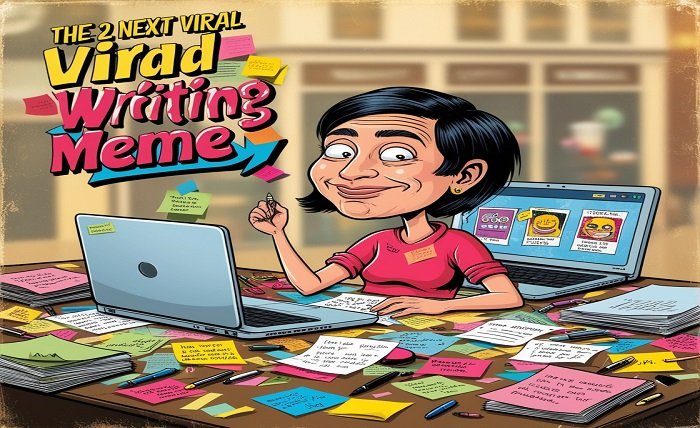Overview
Memes have evolved into a worldwide language in the internet age. writing memes have the ability to enlighten, entertain, and occasionally even spark thought in a way that few other media can, whether it’s through a catchy title, a memorable image, or a well-timed joke. The craft of creating memes has gained prominence as they continue to develop from basic online humor to a societal phenomena.
Why Are Memes Important and What Are They?
It’s crucial to comprehend what memes are before beginning to write them. To put it simply, a meme is a piece of media, generally a picture or video, that circulates quickly online, frequently with minor modifications, and usually has a clever or amusing message. Evolutionary biologist Richard Dawkins first used the time period “meme” in his 1976 ebook The selfish Gene. writing memes are a quick-growing, viral form of communication in today’s digital world, but they’re more than simply jokes; they’re a means for individuals to express their thoughts, feelings, and cultural commentary.
The Essential Components of a Meme: What Gives It Its Buzz?
You must comprehend the essential elements that make writing memes powerful in order to produce them. Among these components are:
Relatability: Because memes are relatable, they frequently succeed. Reliability is crucial, whether it’s a humorous interpretation of a typical circumstance, a response to current affairs, or an amusing insight about human nature. A meme is more likely to strike a chord with a large audience if it speaks to a common experience.
Brevity: writing memes are brief, witty, and direct. The message or comedy must be delivered fast. Particularly on social media, people’s attention spans are short, therefore being succinct is crucial.
How to Write Memes: The Basics
Although creating writing memes may appear to be an impromptu and casual endeavor, memes are popular because of a fundamental structure. The following fundamental stages will help you navigate the process:
Start by coming up with a concept: What will the meme be about? Consider the message you want to convey. Is it a remark on anything going on in the world, or is it a humorous observation on something you’re going through? Decide on the idea before you begin creating the meme.
Select the format: writing memes come in a wide variety of formats, from well-known image templates (like “Distracted Boyfriend” or “Mocking SpongeBob”) to unique images or even video memes. Decide which format best suits your concept.
Meme Types You Can Write
There are many different kinds of writing memes, but some are especially popular and successful. Below is a summary of the most common meme categories:
The most prevalent: kind of memes are image macros, which include a caption appended to a particular image. Usually, the situation, posture, or attitude in the picture is related to the text. The “achievement youngster” and the “Grumpy Cat” are traditional examples.
Reaction: memes are made to convey a feeling or response to a circumstance. They frequently convey a sense through pictures or brief snippets from viral videos, TV series, or films. Using a scene from “The Office” to convey perplexity or annoyance is one example.
Memes and Their Psychology: Why Do We Laugh?
writing memes are humorous or captivating because they appeal to a number of psychological responses. You may create more captivating and effective memes by being aware of these triggers.
Incongruity Theory: Surprises and contradictions frequently lead to humor. writing memes take use of this by contrasting text and visuals that don’t quite go together or by taking a well-known situation and turning it in a novel way.
Relief Theory: By making comments about events that are unpleasant or frustrating for everyone, memes might offer a sense of release or relief. Expressing something that everyone feels but may not have said out loud is what makes it funny.
Typical Errors to Avoid When Composing Memes
Although creating memes can be enjoyable and simple, there are a few typical mistakes to avoid. Your meme may become less successful or perhaps embarrassing as a result of these errors.
Making the joke too complicated: writing memes are meant to be brief and straightforward. Your joke is probably not a meme if it needs too much explanation. preserve it short and to the factor.
Being overly specialized: Although inside jokes might be amusing, memes that are excessively specialized risk failing if they don’t appeal to a wider audience. Achieve equilibrium between accessibility and distinctiveness.
Trying too hard: A meme that is forced or overthought may come across as unauthentic. Memes frequently function best when they seem authentic, organic, and unplanned.
Conclusion
Anyone can learn how to writing memes, which is an entertaining and creative ability. You can begin creating humorous, shareable, and potentially viral memes by learning the fundamentals of meme generation, utilizing psychological triggers, and experimenting with various styles. The power of comedy and relatability can help your material stand out in a busy digital world, whether you’re making memes for your own amusement, developing a social media following, or even using memes as part of your business strategy.
FAQ
Which tools are the best for creating memes?
Well-known tools for creating writing memes include Canva, Meme Generator, Kapwing, Imgflip, and sophisticated photo editing programs like Photoshop or GIMP. Read more about: phongsavanh bank ltd boiler room scam
How can I create memes that go viral?
Use popular topics to stay current, make sure your meme is funny, and interact with like-minded online communities to boost your chances of becoming viral.
Is it possible to use memes for marketing?
Yes, companies and brands can use writing memes to promote their products, but it’s crucial to make sure the humor is genuine and fits with your brand’s voice. Steer clear of overusing memes or introducing inappropriate humor.

